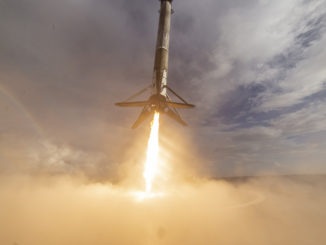
Indian engineers hope to launch the country’s first robotic lunar lander between July 9 and July 16 on India’s most powerful rocket, the head of the Indian space agency said this week.
The robotic Chandrayaan 2 mission will launch on the heaviest rocket in India’s inventory, the Geosynchronous Satellite Launch Vehicle Mk.3, from the country’s spaceport on Sriharikota Island, located on the coast with the Bay of Bengal around 50 miles (80 kilometers) north Chennai.
The mission’s week-long launch period opens July 9, according to K. Sivan, chairman of the Indian Space Research Organization. Chandrayaan 2 is the next mission on India’s launch calendar after Wednesday’s liftoff of a Polar Satellite Launch Vehicle carrying the RISAT 2B radar observation satellite.
“The next mission is the most complex mission ISRO has ever undertaken, that is the Chandrayaan 2 mission,” Sivan said in remarks after Wednesday’s launch of RISAT 2B. “It is not only a launch mission. We are going to land precisely at a place where nobody’s ever gone. This is challenging for the whole ISRO team. I don’t have any doubt that team ISRO will achieve the target of this mission, with the precision of what we’re aiming for.”
The launch of Chandrayaan 2 would come just shy of the 50th anniversary of the Apollo 11 and landing.
Chandrayaan 2 consists of three segments, an orbiter module to guide the spacecraft to the moon, a descent stage to land on the lunar surface, and a rover to scout the landing site in the southern lunar highlands.
If the launch occurs in the July window, Chandrayaan 2’s landing is scheduled for Sept. 6, Sivan said.
The mission will be India’s first attempt at a lunar landing, seeking to become the fourth country to accomplish a soft landing on the moon after the former Soviet Union, the United States and China.

India launched its first lunar orbiter, named Chandrayaan 1, in 2008. One of Chandrayaan 1’s major accomplishments was the discovery of water-bearing molecules at the moon’s poles, with the highest concentrations inside permanently-shadowed craters at the south pole.
Chandrayaan 2 will aim for touchdown in an unexplored region of the moon, targeting a landing closer to the lunar south pole than any previous mission.
The expected landing site is located at approximately 71 degrees south latitude, roughly 220 miles (350 kilometers) from the rim of the South Pole-Aitken basin, a region scientists believe is one of the most ancient impact sites in the solar system, created when a large asteroid or comet struck the moon billions of years ago.
For the first time, Chandrayaan 2’s rover could examine ancient material in the lunar crust ejected during the colossal collision that created the South Pole-Aitken basin, providing data that could yield clues about the solar system’s chaotic early history. The rover, named Pragyan, carries an alpha particle X-ray spectrometer to measure the elemental composition of the rocks at the Chandrayaan 2 landing site, along with a laser-induced breakdown spectroscope.
China accomplished the first soft landing on the far side of the moon in January in the mid-latitudes of the southern hemisphere, within the South Pole-Aitken basin. The Chang’e 4 mission’s stationary lander and rover are still operational.
But Chang’e 4 did not carry an X-ray spectrometer to obtain elemental measurements of the lunar crust. The presence of such an instrument on-board Chandrayaan 2 could be boon for lunar geologists.
Five science payloads will each operate on the Chandrayaan 2 lander, dubbed Vikram, and the mission’s orbiter component. The instruments include spectrometers, radars, plasma sensors and cameras.
The Chandrayaan 2 landing craft also carries a passive laser retro-reflector provided by NASA to allow precise measurements between the Earth and the moon, and potentially become a node in a lunar navigation network to help guide future missions.

Chandrayaan 2 will launch on the first operational flight of the GSLV Mk.3, India’s most powerful rocket. The GSLV Mk.3 is powered by two side-mounted solid rocket boosters, among the biggest solid-fueled rockets in the world, generating 2.2 million pounds of thrust at liftoff.
An air-lit core stage with two hydrazine-fueled Vikas engines and an upper stage with a hydrogen-fueled engine will send the Chandrayaan 2 mission into space.
Indian space program managers last year moved the Chandrayaan 2 launch from the less capable GSLV Mk.2 rocket to the GSLV Mk.3 to accommodate mass growth on the lunar mission.
Chandrayaan 2 now has a combined launch mass of more than 3.8 metric tons, or about 8,500 pounds. The mission reportedly costs around $125 million.
After Chandrayaan 2’s launch, ISRO plans another PSLV mission to deliver the Cartosat 3 high-resolution mapping satellite into orbit. Cartosat 3 is the first in a new generation of Indian optical reconnaissance satellites.
Later this year, India plans additional PSLV and GSLV launches, as well as the debut flight of new low-cost light-class satellite launcher named the SSLV.
Email the author.
Follow Stephen Clark on Twitter: @StephenClark1.



